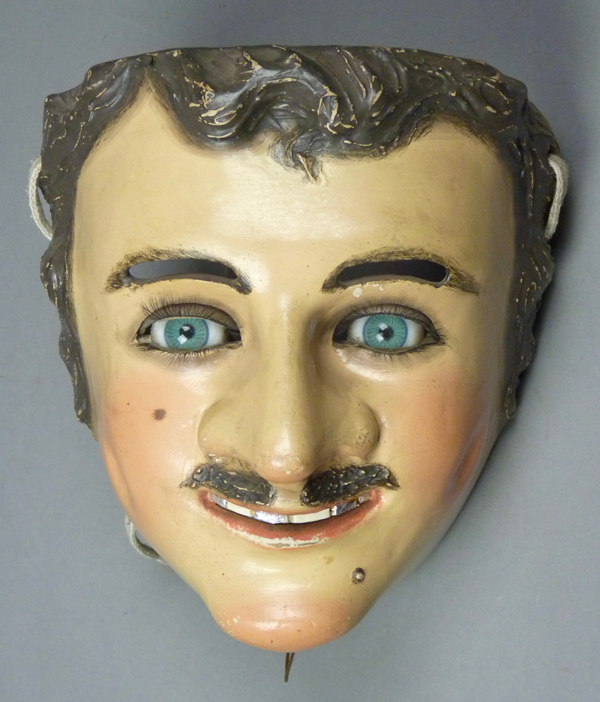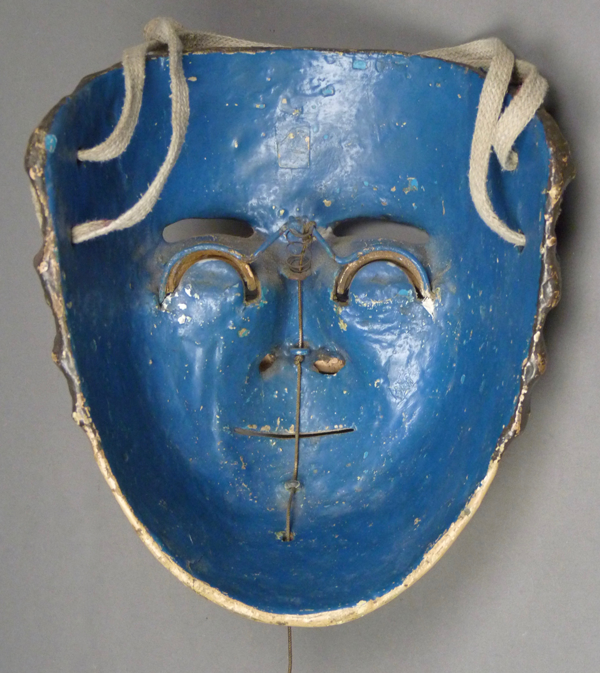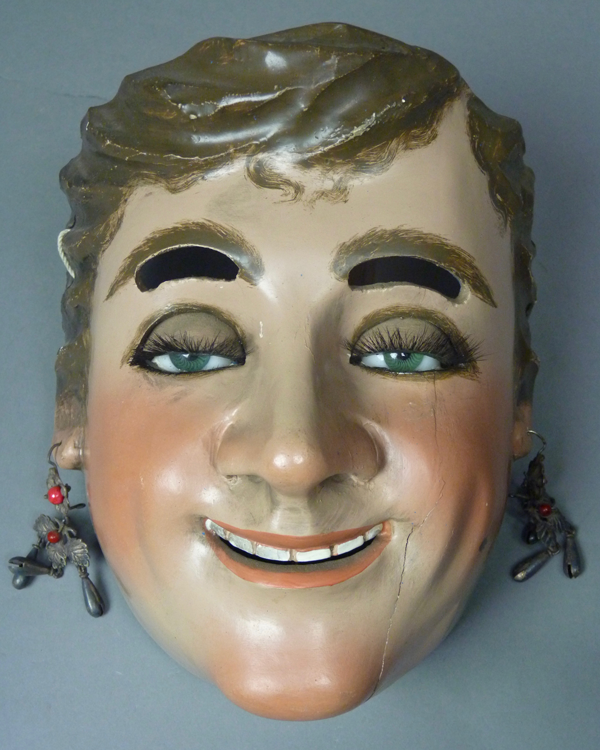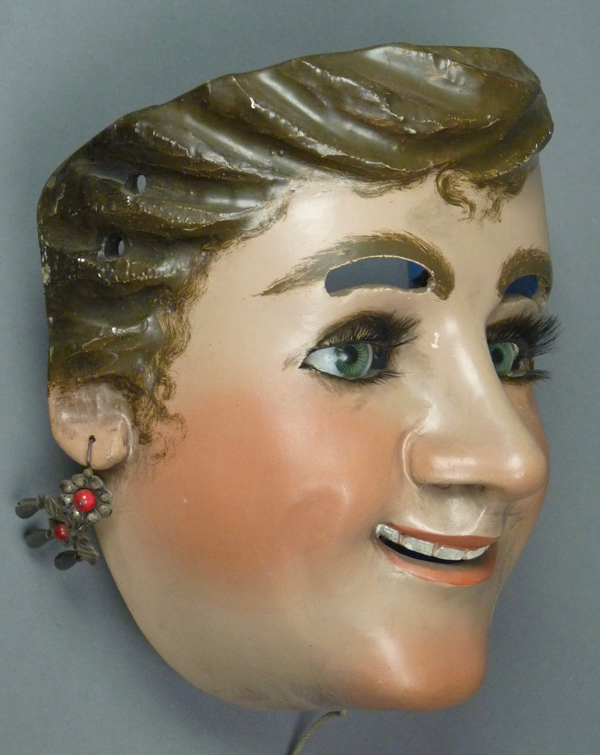In Donald Cordry’s book—Mexican Masks (1980, page 26, figure 29)—we see nine Carnival masks from the Mexican State of Tlaxcala, three of leather, while the other six were finely carved from wood. The dance figure who wears such a mask is often referred to as a Catrin, a word that means “dandy.” The wearer(s) can also be called a Paragüero (umbrella holder) or a Cuadrilla (gang or crew). Under such names the wearers of these masks dance during Carnaval.
Three of the wooden masks in Figure 29 had eyelids that could be opened or shut by the dancer pulling a string. On page 104, plate 147 of Cordry’s book, we find a photo of Carlos Reyes Acoltzi, of Tlatempan, Tlaxcala, with two of his sons, taken in 1971. The caption for that image states that Carlos was a santero, a carver of saints, and a mascarero as well (mask carver). Carlos had carved four of the wooden masks shown in figure 29, including the three with mechanical eyelids.
The religious orders in Mexico, such as the Dominicans, the Augustinians, and the Jesuits, trained Indians in their congregations to be the artisans and craftsmen. Thus Indians were taught to create the wooden statues portraying God, Angels, Devils, and the European Christian saints for display in their churches. It was natural for these santeros to become the makers of dance masks used in religious fiestas, and for those carvers to create masks with the beautiful faces of the saints or the dreadful faces of the Diablos. This practice continues to the present day, and I provided several examples of Santeros who were also mask makers in my book—Mexican Masks and Puppets: Master Carvers of the Sierra de Puebla.
Today we will look at six of these beautiful Catrin masks. I will begin with a pair that appeared in my post of August 18, 2014, to illustrate the level of quality of the traditional masks in Cordry’s book (in contrast to other masks there that were invented, falsely labeled, and therefor “decorative”). I had purchased these masks from Robin and Barbara Cleaver in 2000. They believed that the two were carved in the 1930s or 1940s, and that their doll’s eye movements had been imported from Germany in the 1930s.
These Catrin masks have the beautiful faces of saints. The paint on the face of this mask is obviously worn. If the string that hangs under the beard is pulled, then the eyelids will close.
Figure 33, on page 29 in Cordry’s book, shows a costumed dancer wearing one of Señor Acoltzi’s masks. Figure 93 on page 70 shows a group of these masked dancers. Cordry commented that the dancers are carrying umbrellas for an interesting reason; these dancers are petitioning for rain. You may recall that the Tlacololeros of Guerrero dance for a similar purpose.
Two of those photographs (figures 33 and 93) had been taken by Ruth Lechuga, a Mexican anthropologist. In Mask Arts of Mexico (1994), a book written by Ruth Lechuga and Chloë Sayer, Plate 17 shows one of these Catrin masks. made by either Carlos Reyes Acoltzi or his son, José Reyes Juárez. That mask was photographed with the eyes closed, as it was one of those with doll’s eye movements that permit the eyelids to open and close. Plate 18 shows a masked dancer wearing such a mask; his eyes are open. Plate 36, on page 36, shows yet another dancer wearing this style of mask, but this one has a female face The authors commented that this one also has eyelids that close.
Now here is the first mask, with closed eyelids.
The fine quality of the carving of this mask is obvious. It is typical for these Catrin masks to have “beauty marks.”
This mask is 9 inches tall, 6¾ inches wide, and 4 inches deep.
Looking at the back of this mask, the paint is worn from use. Here is the dolls eye mechanism. Pulling the string will draw the peaked wire forward, lowering the eyelids.
This female mask has the same dolls eye movement.
Pulling the string on this mask has the same effect.
This mask is equally worn. The movable lid is visible in the open position, if one knows what to look for.
This female mask has prominent dimples. It is 8 inches tall, 6¾ inches wide, and 4 inches deep.
This is another worn back. The dolls eye movement is just the same as the one on the male mask.
The next pair of masks were purchased from Jaled Muyaes and Estela Ogazón in 1998. Like the other two, these masks were thought to date to about the 1930s, and have the same early 20th century dolls eye movements. This mask lacks a beard.
This is another mask with a handsome face and beauty marks. In this frontal view, one can just barely see that there are separate eyelids.
The eyelids are equally difficult to see in this side view. The dimples resemble those on the female mask above. This mask is 7½ inches tall, 6½ inches wide, and 4 inches deep.
One can see that the paint on the back of this mask is worn.
The second female mask has green eyes and an engaging face. There is a small crack under the left eye and along the left side of her chin.
I am showing this mask with the eyelids half closed, which makes this face look flirtatious, doesn’t it?
Note the fine quality of the painting on this mask.
This mask is 7½ inches tall, 6½ inches wide, and 4 inches deep.
The crack on the left side of the face doesn’t extend through to the back. The paint on the back of this mask looks fresh. The arrangement of the holes at the upper corners is typical for these masks, and the dancer usually ties the mask to his face by threading a green ribbon through these holes.
Next I will show you another male Catrin mask. Like the last male, this one lacks a beard. There are glass eyes, but it lacks mechanical eyelids. This one probably dates to the mid 20th century. I bought it from Robin and Barbara Cleaver in 1994.
There is that typical gren ribbon.
This mask is 6¼ inches tall, 6 inches wide, and 3¾ inches deep.
This is another mask with a mild crack on the face that doesn’t extend through to the back.
In Changing Faces: Mexican Masks in Transition (1985, pages 32-36) there are six interesting and attractive Catrin masks from Tlaxcala. All of these have glass eyes, but just 0ne appears have the mechanical eyelids that can open or close. On page 32 (plate 26) there is a conventional male Catrin mask with a beard, on page 34 (plate 28) there is another (the one that may have mechanical eyelids), and on page 35 (plate 29) there is a third pink faced Catrin mask with a mustache but no beard. The first two look like the first male mask in this post, while the beardless mask resembles the one we just saw. All three of these masks were identified by a panel of experts as traditional “Paraguero, Cuadrilla, or Catrin masks” from Tlaxcala. However the other three masks were identified as “Character unknown. Various dances,” from Tlaxcala. In other words, the experts did not doubt the authenticity of this trio, but they found them unfamiliar. What was so different about these three masks? One (page 33, plate 27) had a mustache, no beard, and was painted bright red. Another, on page 36 (plate 31), resembled the red mask except for its complexion, which was dark green. The third. with white hair and beard, had black skin. All three of these are indeed mysterious, striking, and rare. They serve as a good introduction for the last mask in today’s post, a handsome male human faced mask with brown complexion, which I bought from Robin and Barbara Cleaver in 2007. They reported that these brown faced Catrin masks represent Gypsies.
I did find a brown faced Catrin on a video of the work of Pedro Reyes Ramirez, who is probably a descendant of Señor Acoltza, at 1:42.
https://www.youtube.com/watch?v=1kBpQ9U3GwI
This is an interesting video, as we see the carver shape the wood to the m/l desired contours, and then he applies gesso (plaster), whch can be sanded very smooth. This use of gesso under the paint is a typical technique of the traditional santeros.
Isn’t this a handsome face! This mask is 7 inches tall, 6 inches wide, and 4 inches deep.
In this case we see cracks on the face that do extend to the back of the mask. One crack extends down from the left eye to the left edge of the mouth, while another drops from the middle of the mouth down to the chin. The paint on the back of this mask looks fairly worn.
I hope you liked seeing these Catrin masks. I greatly admire them, as obvious continuations of a santero tradition that is several centuries old.
Next week we will look at some Moro masks from the State of Mexico, an area that surrounds the capital city of Mexico and the D.F. (Distict Federal).
Bryan Stevens





















